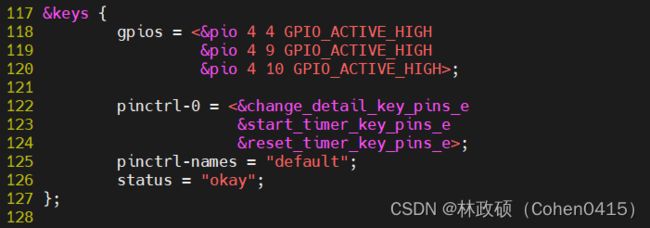荔枝派nano(f1c100s)中断按键驱动
硬件环境:
1、荔枝派nano(f1c100s)
软件环境:
1、Linux 4.15
文章目录
- 一、GPIO子系统
- 二、程序大致流程
- 三、按键原理图
- 四、完整的驱动程序
- 五、测试结果
- 六、总结
一、GPIO子系统
GPIO子系统是操作系统内核提供的一个软件接口,用于控制和管理硬件上的通用输入输出引脚;可以理解GPIO子系统的诞生方便了驱动工程师,为什么?因为这样驱动工程师在编写相关GPIO驱动程序时就可以使用GPIO子系统提供的API来完成对GPIO的配置。又有一个问题:GPIO子系统怎么知道我用的是什么芯片什么板子,它凭什么能帮我完成对具体芯片的GPIO的配置?没错,GPIO子系统是一个软件的概念,它对外的接口是统一的,它背后的具体实现是由每个不同的芯片厂家的BSP工程师来完成的。 所以是BSP工程师完成了对寄存器的操作等其它事情。所以芯片厂家对GPIO子系统实现了很强的支持,则你用起来就会很舒服,但并不是所有芯片厂家都这样。
二、程序大致流程
1、从设备树获得 GPIO;
2、从 GPIO 获得中断号;
3、申请中断;
4、实现中断函数;
三、按键原理图
四、完整的驱动程序
设备树如下,gpios中添加了三组GPIO信息
suniv-f1c100s-licheepi-nano.dts

完整的驱动程序如下:
#include 完整的测试应用程序如下:
#include \n" , argv[0]);
return -1;
}
/* 2. 打开文件 */
fd = open(argv[1], O_RDWR);
if (fd == -1)
{
printf("can not open file %s\n", argv[1]);
return -1;
}
/* 3. 写文件 */
while(1)
{
read(fd, &val, 4);
printf("get button : %d\n", val);
}
close(fd);
return 0;
}
五、测试结果
六、总结
以上出现的专业术语或名词解释或个人理解有不妥,欢迎指出!


